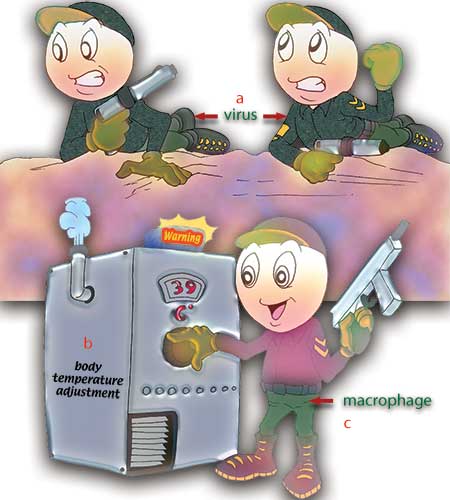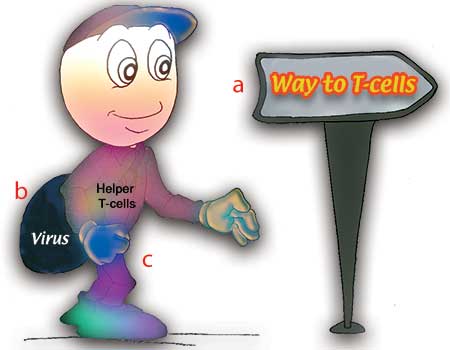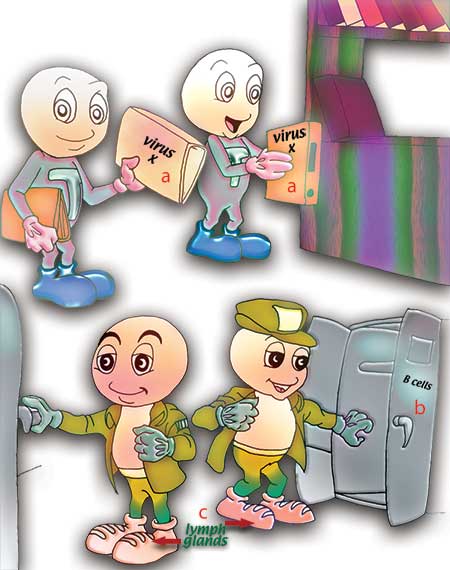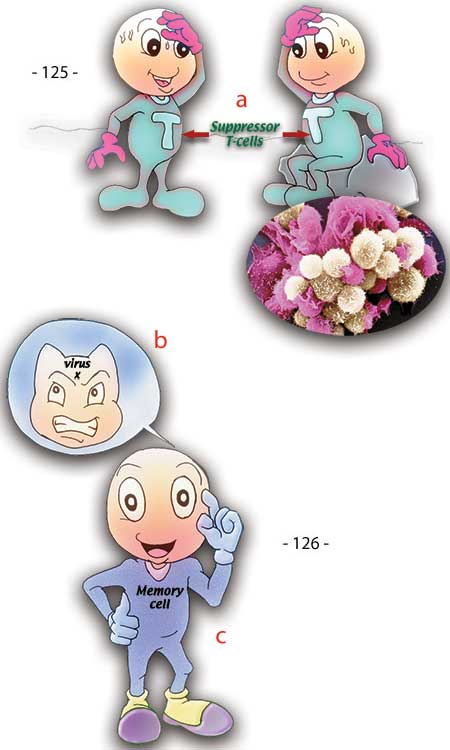The immune system that protects our bodies against enemy bacteria and viruses works much like a disciplined army. The immune system’s war against our microscopic enemies consists of three major stages:
1- Identification of the foe: first intervention.
2- Intervention by the real army: intense warfare.
3- Return to peacetime conditions.
Before declaring war, the immune system first has to identify the foe and obtain intelligence regarding it. Every war differs, according to the nature of the enemy. And unless this intelligence-gathering is done properly, our immune system could attack our own cells by mistake.
The first intervention comes from the phagocytes, the body’s “dustmen” or janitors. The phagocytes declare war on the enemy. They are rather like infantry units that establish the first contact with enemy combatants (Figure 117).
 |
| a. Virus |
| Figures 117 and 118: Phagocytes engage in face-to-face combat with the enemy. If they fail to do their job, then macrophages enter the fray and raise the temperature of the body up to 39oCelsius (102 0 Fahrenheit) in order to provide energy. |
Sometimes the phagocytes are unable to match the speed at which the enemy multiplies. In that event, the macrophages go into action. Macrophages may be compared to cavalry striking at the mass of the enemy troops. At the same time, thanks to a special protein they secrete, macrophages sound the general alarm in the body, by raising its temperature by fever (Figure 118).
Macrophage cells have another very important property, however. They can trap and engulf a virus, breaking off a particular section of it, which it then carries like a flag. This part acts like a sign for other components of the immune system, and also demonstrates the intelligence of advance planning.
 |
| a. Way to T-cells |
| Figure 119: Helper T-cells carry information about the enemy to killer T-cells. |
The first task of the helper T-cells that identify the enemy, thanks to the intelligence obtained by the macrophage, is to notify the killer T-cells and stimulate them to multiply (Figure 119). Thus stimulated, killer T-cells soon become an army. The helper T-cells do not only stimulate the killer T-cells, but also ensure that many phagocytes attend the battlefield and transmit the information they’ve gathered concerning the enemy to the spleen and lymph glands (Figure 120).
When the lymph glands are reached, B cells that have awaited their call to duty are set in motion thanks to this information. After being produced in the bone marrow, B cells travel to the lymph glands to await the call to action (Figure 121).
 |
| a. Virus x |
| Figures 120 and 121: The information about the enemy collected by the helper T-cells is sent to the lymph glands, where waiting B cells go into action. |
The awakened B cells go through a number of stages. Every stimulated B cell begins to divide and multiply, until there are thousands of cells of the same type. The B cells, now ready for the fray, divide further and become plasma cells that release antibodies, chemical weapons to be used in the war against the enemy. B cells can produce thousands of such antibodies in a second, which weapons are highly practical. They will first bond to the enemy antigen, and then impair that foe’s biological structure (Figure 122).
 |
| a. B cells |
| Figures 122 and 123: B cells multiply by dividing and are then differentiated. As a result, they are able to produce thousands of the weapons known as antibodies. If the antibodies are unable to catch the virus, then T-cells take over, identifying and trapping the viruses thanks to the MHC molecules. |
If a virus enters the cell, the antibodies are unable to trap the virus. In that event, the killer T cells again go into action and identify the viruses inside the cell, thanks to the MHC molecules, and kill the cell (Figure 123).
However, if the virus is camouflaged in such a way that not even the killer T-cells can detect it, then cells known as natural killer (NK) cells take over, destroying the cells that the others could not identify and which contain the viruses (Figure 124).
Once the victory has been won, the suppressor T-cells call a halt to the fighting (Figure 125). The war is now over, but it will never be forgotten. Memory cells have by now recognized the foe, and these cells remain in the body for years. When the same enemy is ever encountered again, they will trigger a defense response that is rapid and effective (Figure 126).
 |
| Figure 124: NK—that is, natural killer— cells destroy the viruses that the killer T-cells have missed. |
The heroes of this war receive no military training, and are not rational human beings, but rather tiny cells, millions of which would still fail to fill the space occupied by a period on this page.
Furthermore, this army with its astonishing properties is not limited to fighting alone. It produces all the weaponry to be used during the war, draws up the battle plans and strategies, and cleans up the “battlefield” once the fighting is over.
Like everything in the universe, our immune systems behave in line with their creation. As Almighty God reveals in the Qur’an:
Hearkening to its Lord as it is bound to do! (Surat al-Inshiqaq, 2)
 |
| a. Suppressor T-cells |
| Figure 125: Suppressor T-cells call a halt to the war once the victory has been won. At the side can be seen defense cells (yellow) fighting a cancer cell (pink). Figure 126: At the end of the war, the memory cells record information about the enemy in order to be ready for the next assault. Every detail in the defense system is a manifestation of our Almighty Lord’s incomparable and flawless artistry. |